JULIAN OF NORWICH, HER SHOWING OF LOVE AND ITS
CONTEXTS ©1997-2024 JULIA
BOLTON HOLLOWAY || JULIAN OF NORWICH || SHOWING OF LOVE || HER TEXTS || HER
SELF || ABOUT HER TEXTS || BEFORE JULIAN || HER CONTEMPORARIES || AFTER JULIAN || JULIAN IN OUR TIME || ST BIRGITTA OF SWEDEN ||
BIBLE AND WOMEN || EQUALLY IN GOD'S IMAGE || MIRROR OF SAINTS || BENEDICTINISM || THE CLOISTER || ITS SCRIPTORIUM || AMHERST MANUSCRIPT || PRAYER || CATALOGUE
AND PORTFOLIO (HANDCRAFTS, BOOKS ) || BOOK REVIEWS || BIBLIOGRAPHY || Lecture given at Wellesley
College, 5 March 2007
WOMEN IN OUR OWN WRITE/RIGHT
JULIA BOLTON HOLLOWAY
I
shall begin with images of women in our own write/right
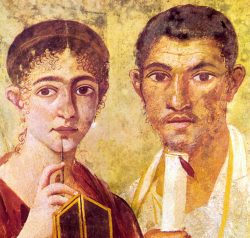 Wife
and husband, Pompeii
Wife
and husband, Pompeii

 Volmar, Hildegard of Bingen, Richardis
Volmar, Hildegard of Bingen, Richardis

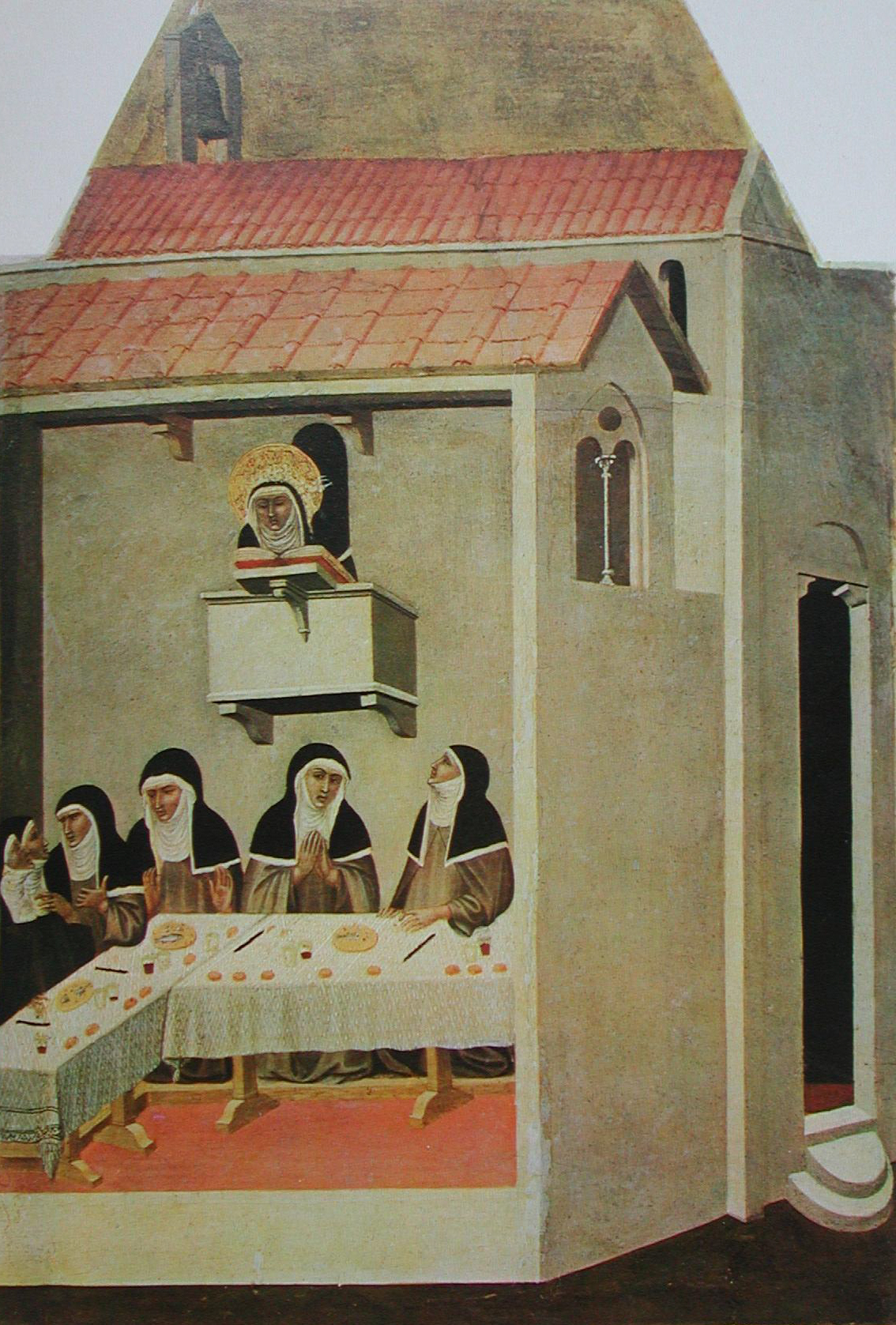
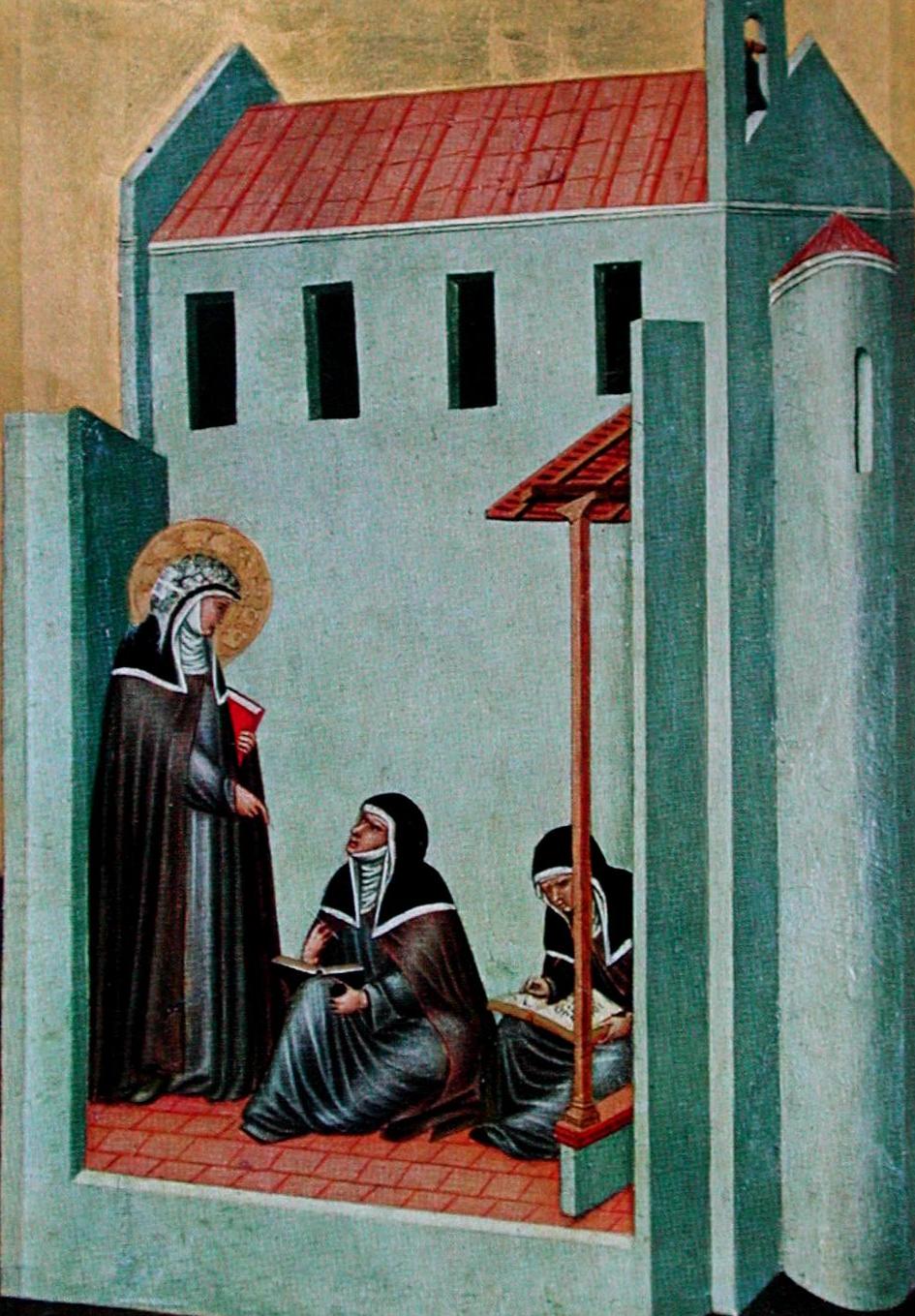 St Umiltà of Faenza, Florence
St Umiltà of Faenza, Florence

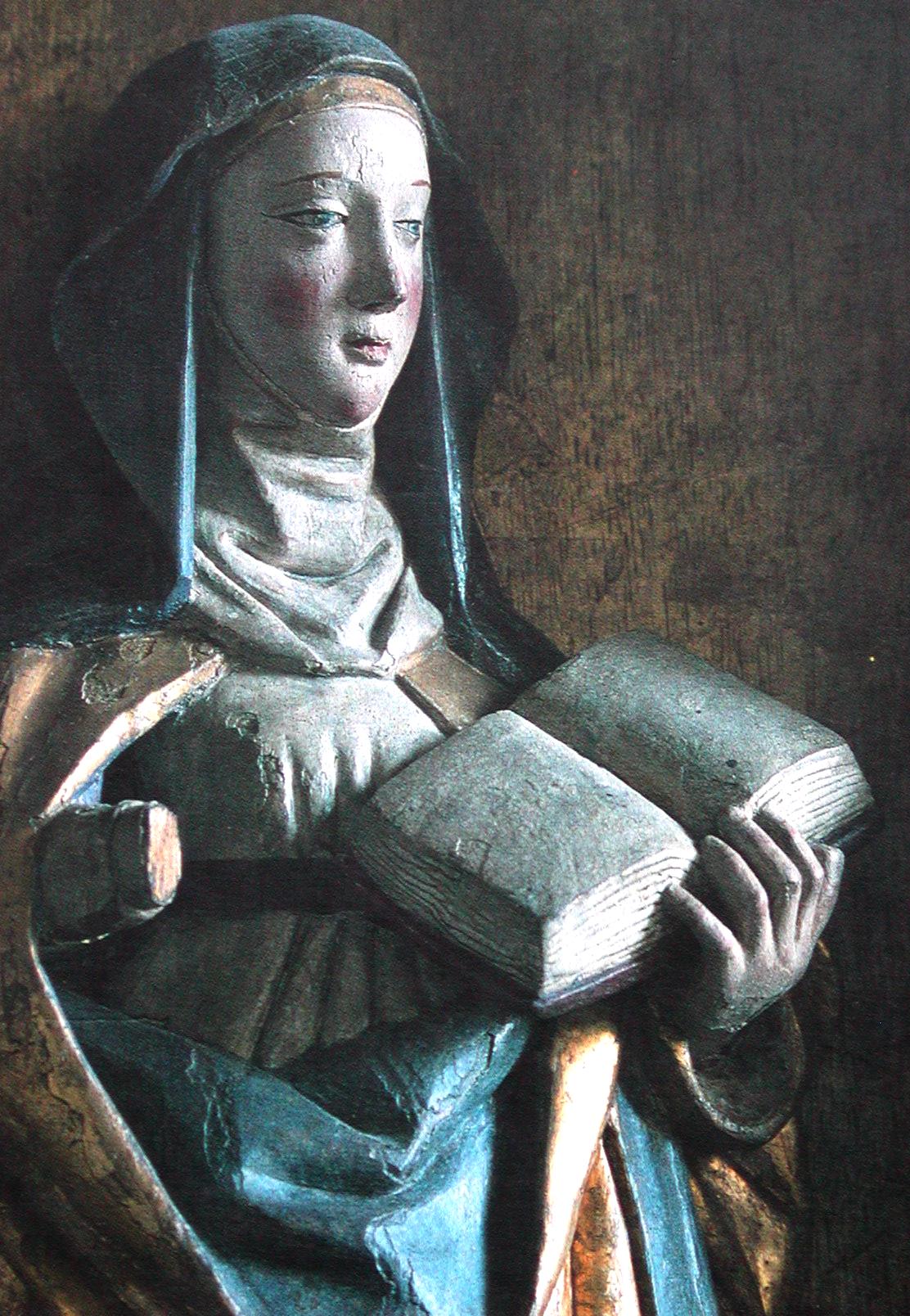 St Birgitta of Sweden
St Birgitta of Sweden

 Suor
Juana de la Cruz
Suor
Juana de la Cruz  St Teresa de Avila
St Teresa de Avila


 Elizabeth Barrett Browning
Elizabeth Barrett Browning


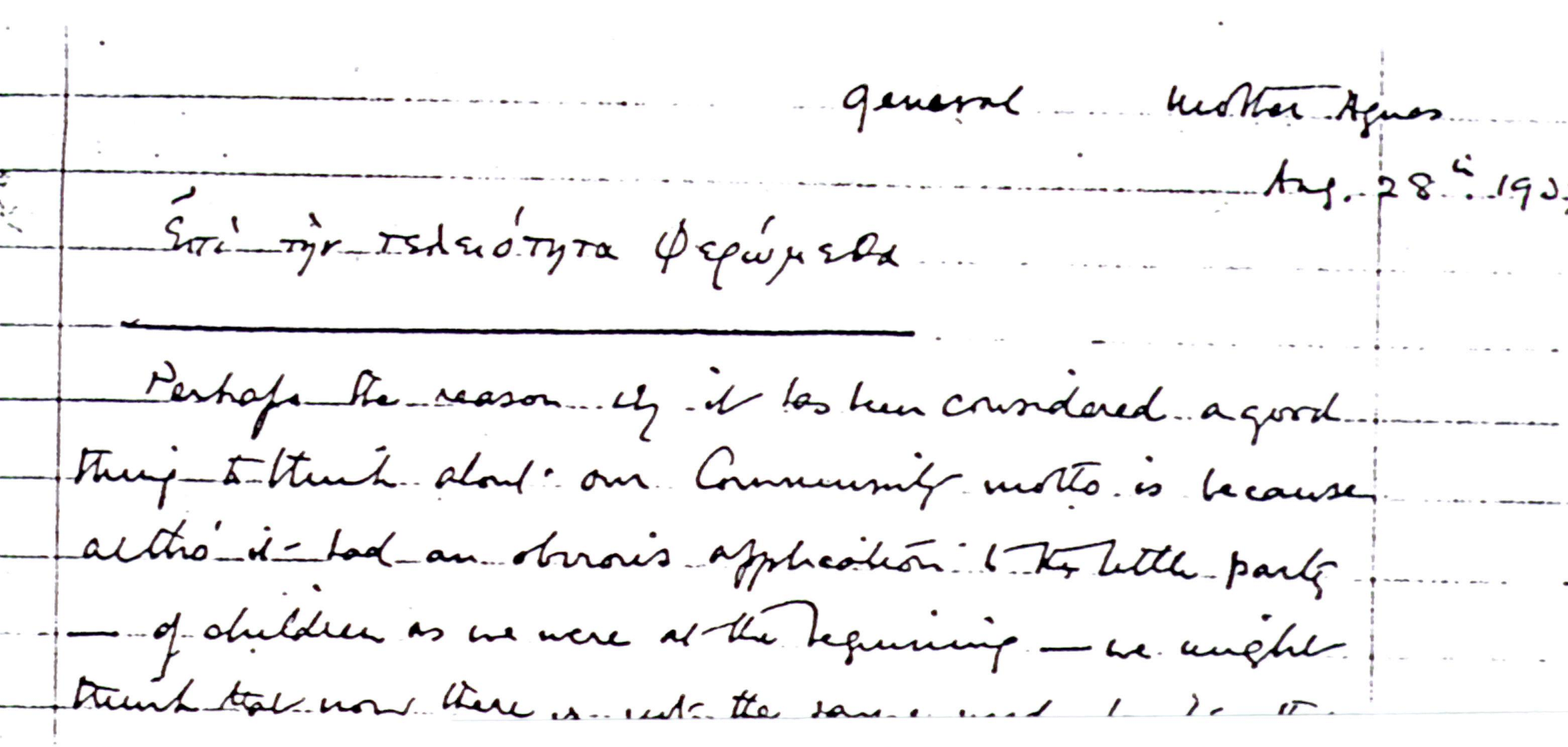
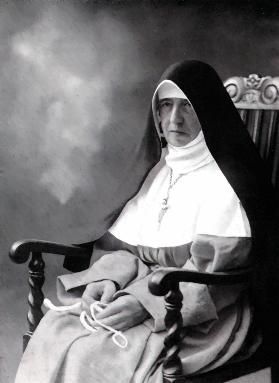 Mother Agnes Mason, C.H.F.
Mother Agnes Mason, C.H.F.
This is a talk taking us from cradle to grave. I live in a
graveyard and I make cradles.
Alex has
told you my story. That I was a university professor who, in
1992, went back to my Anglican convent school in Sussex to
be a nun and librarian of 20,000 books, assembled by learned
women in the nineteenth century, when women in England could
not have degrees. It had been founded by Mother Agnes Mason
of the Community of the Holy Family, with another school at
Naini Tal in India and she also helped her brother with St
Bede's College, Umtata, South Africa, where Black priests
were excellently trained. Greek was required and Hebrew
encouraged for the nuns' Profession. My first memory at six
years old during WWII was of its utter beauty, William
Morris wallpaper, Della Robbia sculpture, carved medieval
and Renaissance wood, for Mother Agnes wrote into our Rule
that a sin against beauty was a sin against the Holy Ghost,
and she insisted on the school for children, of all classes,
being very beautiful. She had translated St Teresa of
Avila's Foundations,
publishing it with Cambridge University Press, and it had
been enthusiastically reviewed by major Oxford Movement
bishops and clergy. But then my twentieth-century bishop
sold our convent, bulldozing it, putting our books down at
sea level, sending us away without a penny. I was allowed to
leave with my personal books, one basket of their books, my
computer, and the convent's book-binding press and tools. I
had to give back my nuns' clothing sewn by myself. The nuns
had already given my secular clothing to the cook. So I
sewed two habits and veils for my hermit garb. Then fled
from England to Italy, using the last of my life-earnings
paying for the van and driver to bring the boxes upon boxes
of books. For four years these were in one unheated room
with me above Fiesole. It was during that time that I began
web-weaving.
I came to Florence, deciding that since my life was become
meaningless I may as well be in a place of beauty, where in
fact my Mother Foundress had dreamed up our community,
sitting in an olive tree above Fiesole. And also because,
summer after summer, and indeed
one whole glorious Sabbatical year, I had been doing research in Florentine libraries
amongst manuscripts on Dante's teacher, Brunetto Latino, and
then on St Birgitta of Sweden.
When I began web-weaving, back in its pioneering days, in
1997, a Syracuse
University librarian in Florence taught me html, a Dante scholar in Germany shared some of his AOL space
with me and and a Nota Bene expert in Leeds taught me how to
compose webpages with Netscape and how to ftp files. But
then I outgrew the AOL space. Next, I had free webspace on
Geocities. And my Geocity town was, believe it or not,
Wellesley. Following that, for more space, I went to Fortune
City, which I hated. Russian
friends in Pskov also did, for they are an icon painting
school, and to their disgust were hi-jacked by Korean
pornography. So,
greatly daring, I bought space, without advertising, on a
server which operates out of Scotland. Googling through these archeological layers of ten
years of web-weaving will yield many web references and
links, including those to the long ago orphaned, abandoned
Wellesley Geocities website.
The Umilta Website is named after the illiterate Florentine
saint, who was Dante's contemporary, and whose nuns wrote
down her magnificent sermons.

After four years the Protestant of the Swiss church
found me and gave this now-Catholic hermit the Gatehouse of
Florence's 'English' Cemetery to use for a library if I
would be custodian of their Cemetery. A miracle. So I next
created a website about Florence and its famous Cemetery,
and which I named Florin, the medieval coin that was then
Europe's 'Euro'.
Europe's First
Euro
The Florin of Florence


Lily of Florence John the
Baptist, Patron of Florence
Remember that in English and American law it is required to
have the body, the Writ of Habeas Corpus. I actually
have/habeo the bodies of Elizabeth Barrett Browning, Fanny
and Theodosia Trollope, Walter Savage Landor, Arthur Hugh
Clough, Jean Pierre Vieusseux, Hiram Powers and many other
famous writers and sculptors, about whom I now write, who
all lie within this oval in the midst of Florentine traffic.
It is Arnold Boecklin's 'Island of the Dead', for he buried
his infant daughter, Maria Anna, here (§142. Böcklin/+/ Maria Anna/ Arnoldo/ Svizzera/
Firenze/ 20 Marzo/ 1877/ Mesi 7/ 1387). Serge
Rachmaninoff composed his symphony on this painting.

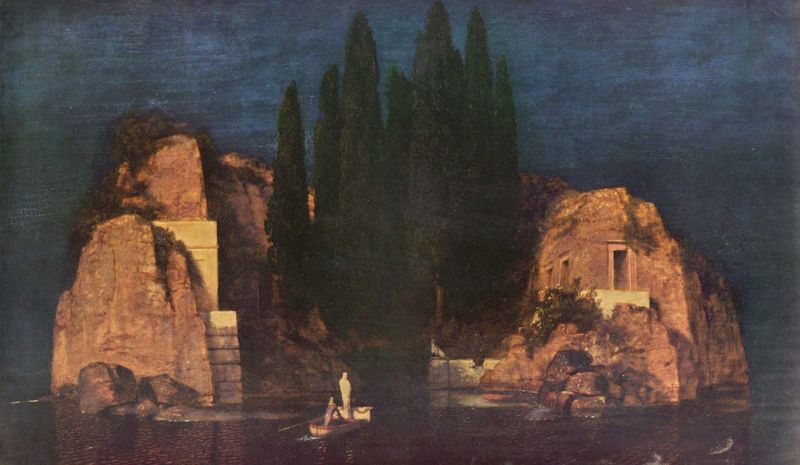
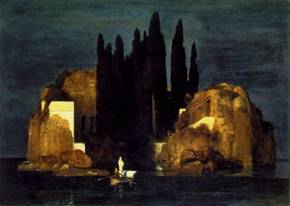
1880 New
York/
1880
Basel/

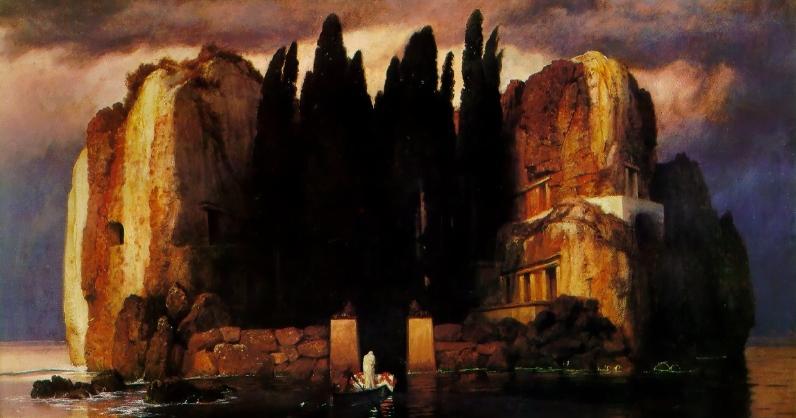
1883
Berlin/
1886 Leipzig
I also have
sculptures by Félicie de Fauveau, Hiram Powers, Joel Hart,
Holman Hunt, Frederic Lord Leighton, Lorenzo Bartolini,
Odoardo Fantacchiotti and many others. I have the body of
Henry Adams' sister, Louise Adams Kuhn, about whom he wrote
in the Chaos chapter of his 'Education of Henry Adams. I
collect the books they wrote and books written about them
for our library. I also weave websites concerning them.
Now some hints as to how to weave webs http://www.umilta.net/weaveweb-html
and build cradles and bookcases! Netscape no longer exists,
done in by Microsoft. So instead download its successor,
Mozilla's browser, SeaMonkey, go to 'edit', then to 'new',
then to 'composer'. It's simple and free and so is colour. I
use the memory technology of medieval manuscripts, in
particular their alternating reds and blues. If you have
ever seen a baby born you will know that its umbilical cord
is the most vivid red and alternating blue, pulsing with
life, until cut. This is a talk
taking us from cradle to grave. I live in a graveyard and I make
cradles! Now let us go to http://www.umilta.net/cradle.html
which I wrote some years ago.
HOW TO
BUILD CRADLES
AND
LIBRARIES
Dedicated to my three beloved sons.
 used to accept Heloise's
desperate plea to Abelard that scholars and babies, books and
cradles, pens and distaves, do not mix. I now believe they
can. In our library, that I built, I make cradles, too. I also
remember the line in one of my mother's books, on Austrian
women, that the hand that rocks the cradle is the hand that
rules the world. We women internalize men's contempt for us.
Negating ourselves, striving to be powerful men. [What changed my mind was
Hedera. Hedera is Rom from Romania, who has had two babies
born here in Florence. Soon after the second was born I took
her and her baby and her husband in and they slept in my
cell for a week, following the baptism of little Leonardo in
that cell. While I slept in our library. Cradles are not
meant to be in nuns' or anchoresses' cells! I had already
made a cradle for Hedera, modeled on those I saw in the Rom
camps, but a cradle is not possible when one can only live
in the streets, the Orthodox gypsies not being allowed in
the Moslem gypsy camps. Next, the Romanian gypsies were
rounded up by the Italian police and forced to return to
Romania. So then I made cradles to sell them to benefit
Hedera and her three children, and indeed all the twelve children living with her mother and father in a camp
in Buzau. Later, I succeeded in buying a house for them
there. The children are now going to school, unlike their
mother, learning to read and write.]
used to accept Heloise's
desperate plea to Abelard that scholars and babies, books and
cradles, pens and distaves, do not mix. I now believe they
can. In our library, that I built, I make cradles, too. I also
remember the line in one of my mother's books, on Austrian
women, that the hand that rocks the cradle is the hand that
rules the world. We women internalize men's contempt for us.
Negating ourselves, striving to be powerful men. [What changed my mind was
Hedera. Hedera is Rom from Romania, who has had two babies
born here in Florence. Soon after the second was born I took
her and her baby and her husband in and they slept in my
cell for a week, following the baptism of little Leonardo in
that cell. While I slept in our library. Cradles are not
meant to be in nuns' or anchoresses' cells! I had already
made a cradle for Hedera, modeled on those I saw in the Rom
camps, but a cradle is not possible when one can only live
in the streets, the Orthodox gypsies not being allowed in
the Moslem gypsy camps. Next, the Romanian gypsies were
rounded up by the Italian police and forced to return to
Romania. So then I made cradles to sell them to benefit
Hedera and her three children, and indeed all the twelve children living with her mother and father in a camp
in Buzau. Later, I succeeded in buying a house for them
there. The children are now going to school, unlike their
mother, learning to read and write.]
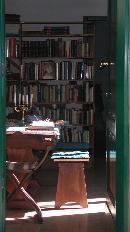
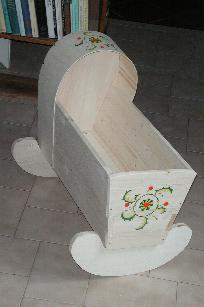
Our library, my second library, and smaller than my first,
is named after a magnificent Florentine, Fioretta Mazzei,
whom I knew and who initiated at Florence's Ospedale degli
Innocenti what became the United Nations Rights of the
Child. This library is a place where gypsies can learn to
write their names to have their babies back from hospital,
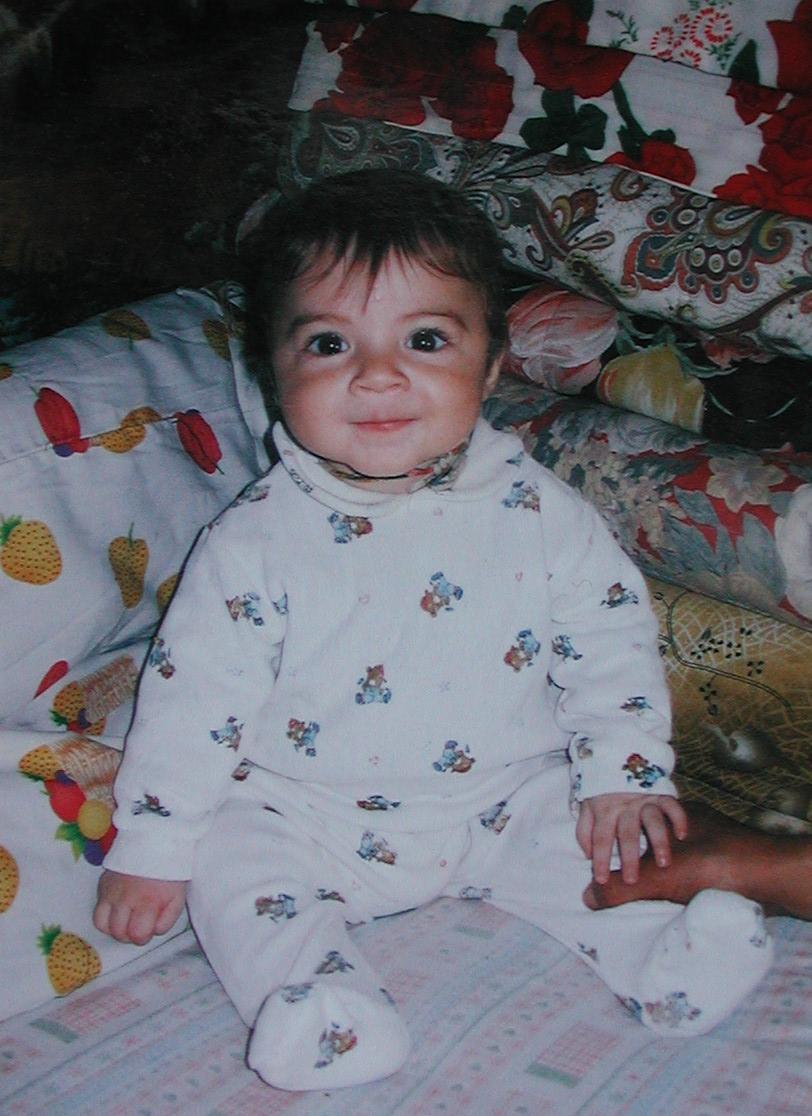
where scholars from Princeton's Institute for Advanced Study
can come and study, and everyone in between, above all women
writing theses on Brunetto Latino, Julian of Norwich,
Elizabeth Barrett Browning, and Lilian Whiting, in Italian,
in English. I made its bookshelves six years ago. But now
keep building them higher and higher. Alex noted from
another essay I wrote, called 'Leopards in the Temple', that
that I believe in putting the
last first from my
experience as a war-deafened child at six, then going from
the back row in school, when they thought I was mentally
retarded, to the front, when they realized I could not hear,
when I was nearly twelve and we were studying about Iraq's
civilization, that gave us literacy and artifacts made with
gold and lapis lazuli. Learning of Hammurabi's and later
Moses' law codes, of cuneiform becoming Hebrew script.

Sumerian Harp, 2500 B.C.

Ur Standard, 2700 B.C., Peace

Ur Standard, War
The
Library, for membership, requires only the gift of a book.
And books pour in from all over the world. Faster than I can
catalogue or shelve them. Here we have read all of Dante's Commedia twice and the
Vita Nuova once
each Thursday evening for two years by candlelight followed
by a shared supper in this same library with ordinary Florentines and foreigners participating,
the women for whom Dante said he wrote.
Our library begins with the alphabet and the Bible in the
original languages, goes on through theology and the
monastic orders, particularly the women contemplatives in
them. Benedict's Rule stated that men and women were to
work, study, pray, using their bodies, their minds, their
souls. A healthy recipe for all three! Which we follow. It
next includes books on pilgrimage, with documentation of my
own pilgrimages to Canterbury, Compostela, Rome, Jerusalem,
Sinai, because I had written my dissertation at Berkeley on
pilgrimage in Dante, Langland and Chaucer, then studied the
woman pilgrims, Egeria, Paula, who journeyed about the Holy
Places, Bible in hand, Birgitta of Sweden, who made all
those pilgrimages, Margery Kempe copying her, I copying
them. Then it has shelves upon shelves of literature,
French, Italian, Russian, Spanish, Portuguese, Icelandic,
Irish, Welsh, English, including the books by and about the
great writers buried in our cemetery in Florence, Walter
Savage Landor, Elizabeth Barrett Browning, Arthur Hugh
Clough, Fanny and Theodosia Trollope. It has shelves on
travel, on art history, on arts and crafts, and for
children, ending where it began with the alphabet. One part
of the library has my publications, books on Dante, on
Brunetto Latino, his teacher, on Birgitta of Sweden, on
Julian of Norwich, on Elizabeth Barrett Browning. We also
print and bind books, using the Victorian wooden press and
book-binding equipment from my convent, making our own
marbled paper. I taught our Rom mother how to marble paper.
I studied paper marbling and book binding under Enrico
Giannini, the fifth generation in his family doing this
craft in Florence. He and I would love to teach you.

We, as a library, organize a series of international
conferences called 'The City and the Book', the city being
Florence, the first on the alphabet and the Bible, in
particular the Codex Amiatinus, the most authoritative
Jerome Vulgate Bible text, written out by Ceoflrith and Bede
in Northumbria and brought to Italy, now in the Laurentian
Library, http://www.florin.ms/aleph.html
the second on the illuminated manuscripts in Tuscany, http://www.florin.ms/beth.html
the third on the 'English' Cemetery, http://www.florin.ms/gimel.html.
Doing this I realized there was need for an international
project editing the Great European Books written for Peace.
Alfonso el Sabio in Spain taught Brunetto Latino on embassy
there from Florence how to create magnificent illuminated
manuscripts, which Brunetto in turn taught to Dante
Alighieri, his student. Hildegard von Bingen already had
created her splendid manuscripts, one of these coming to
Lucca, the town next to Florence. Birgitta of Sweden did the
same, creating an enormous book in many copies to be
presented to Popes and Emperors, Bishops and Kings. She was
copied by Julian of Norwich and by Margery Kempe. Then
Christine de Pizan would copy Birgitta and Dante, but in
France. This tradition continued through time and one can
particularly see it in the eighteenth and nineteenth
centuries with Madame de Staël and her Corinne ou Italie,
which influences Elizabeth Barrett Browning's Aurora Leigh, Anna
Jameson, Diary of an
Ennuyée, and many other books, and also the
Americans, Elizabeth, Mary and Sophia Peabody, and Margaret
Fuller, all so admired by Emerson, Thoreau and Hawthorne. In
a sense I am at an advantage in proposing this study, having
edited Brunetto Latino, Birgitta of Sweden, Julian of
Norwich and Elizabeth Barrett Browning. Common to all of us
is the knowledge of how to create a book, how to edit a
text, how to calligraph or typeset it, how to illustrate it,
how to hand-sew its gatherings, how to bind it in bookcovers
and how to market it as a gift to persons and to libraries
having access to power. Quakers call this 'Speaking Truth to
Power'.
While some of these women were childless, Birgitta had eight
children, Margery likewise many, Christine de Pizan, three,
Margaret Fuller, one, Angelo, and tuberculor Elizabeth who
married at forty, amazingly, one, 'Pen' Browning, who was a
delight to her and to all who knew him. Cradles can be in
libraries! Elizabeth writes about her son Pen in her poems,
Casa Guidi Windows
and Aurora Leigh.
Both the creating of children and of books are empowering.
There was a party for Pen in Rome at which Hans Christian
Anderson read his 'Ugly Duckling' and Robert Browning led
them through all the rooms, while chanting 'The Pied Piper
of Hamelyn'. Elizabeth, dying, wrote her last poem about
this event, conjoining graves to cradles. Last year, I told
this story about stories to a group of brain-injured
patients in wheelchairs, who remembered them! Alcmeon,
Aristotle's physician said 'Man dies when he cannot join the
end to the beginning'.




Birgitta of Sweden, who had had eight children, journeyed to
the Holy Land in her seventieth year with two of them,
having a vision there of the Virgin giving birth to her
Child in a cave that I also have seen, journeying there
prior to entering my convent.
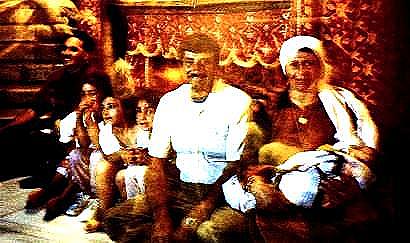

Christine de Pizan's
The Treasure of the
City of Ladies is a
treatise written a generation after Chaucer by an Italian
woman at the court of the King of France whose son was page
to England's Earl of Salisbury. During the 100 Years' War
betwen the two countries. Chaucer's son and granddaughter
likewise had connections with that household, Alice Chaucer
becoming Countess of Salisbury. In this text
Christine gives us sensible advice on how women (and men) in
France, in England, can co-exist, despite jealousy, at court,
in a convent, and even (though this was impossible from the
founding of the universities in the Gothic era to our own
centuries as these institutions rigorously excluded us), in a
college. At the beginning of its text the three allegorical
ladies of Reason, Right and Justice appear to Christine,
telling her to eschew idleness and to write to teach women:
She says:
May all the feminine college and their
devout community be apprised of these sermons and lessons of
wisdom, First of all to the queens, princesses and great ladies,
and then on down the social scale we will chant our doctrines to
the other ladies and maidens and all classes of women, so that
the syllabus of our school may be valuable to all.
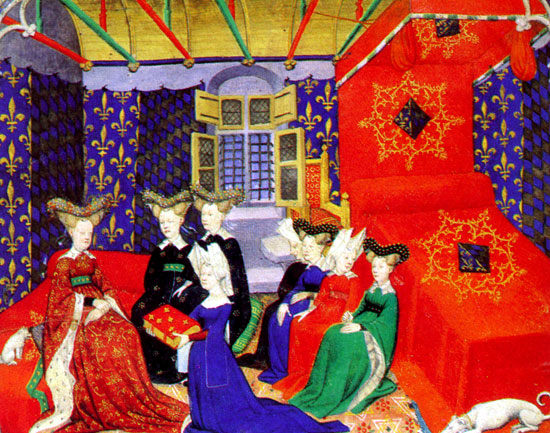
Let us turn now to my major work, the edition of all the
manuscripts of Julian of Norwich, Christine's contemporary.
Influenced by earlier women in the Church, she wrote
contemplative theology as an anchoress in Norwich, in a book she
called A Showing of Love.
At first she was protected by a brilliant Norwich Benedictine
monk and scholar, Adam Easton, who became a Cardinal and who
encouraged her to write a book like that of his friend Birgitta
of Sweden. When he died, England went through a phase very much
like in America following 9/11, when civil rights were taken
away, women specifically forbidden to teach or write or
translate the Bible into the vernacular, on pain of death by
burning at the stake. Julian had been translating directly from
the Hebrew Bible into English, two centuries before the King
James Bible did. She now had to revise her text, remove almost
all the Biblical passages in it, yet keep its integrity. Her
last words are forbidden ones, they are a prayer for her 'even
Christians. Amen.' I was sitting in the British Library reading
that censored manuscript in 1994 when, to my great embarassment,
I found myself in an ecstasy so intense that I had to return the
manuscript, pack up my papers and go home to my convent in
Sussex and pray. Scholars are not meant to respond to texts in
that way. Her manuscripts were first destroyed for being
Lollard, the early form of Protestantism which believed the
Bible should be in our language, not just Latin, then for being
Catholic. They were only preserved by nuns who had to live
abroad in exile following England's Protestant monarchs, Henry
VIII and Elizabeth I. I studied these manuscripts written by nun
scribes that had been preserved by the English Brigittine nuns
in Flanders, Rouen and Lisbon, and by the English Benedictine
nuns in Cambrai and Paris. I found they were so carefully
preserved by them because they knew she was a woman writing
contemplative theology, because she gave them meaning. They did
so at enormous risk. They could be imprisoned, tortured,
starved, hung, drawn and quartered, burnt at the stake, and
eventually faced the guillotine. The Carmelite sisters
imprisoned together with the English Benedictines were so
guillotined at the French Revolution while singing 'Salve
Regina', the English nuns' lives were only saved from the same
fate because of Robespierre's death. These Benedictines returned
to England with their books and manuscripts, wearing the clothes
of the dead Carmelites, having none of their own left.
These are figures in power. But everyone has a story to tell if
we would listen, even the most downtrodden.





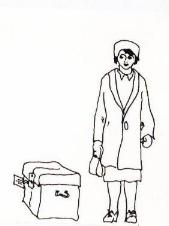
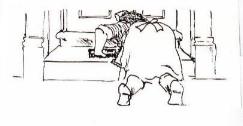

Rose Lloyds often came to visit my convent. One day she told me
she had been writing the story of her life. I read it and was
entranced and begged her to write the rest of it. A friend
illustrated it. I changed nothing. It was perfect. She ends it
by describing going on pilgrimage to Jerusalem. The same
pilgrimage I had made. That Margery Kempe had made. That
Birgitta of Sweden had made. That Holy Paula had made. That
Egeria had made. Each writing or having books written about our
pilgrimages. We sent the manuscript to Virago Press. Now Rose
had grown up in an orphanage, having been abandoned by her gypsy
parents, had won a book prize at the orphanage school, Lorna Doone, presented to
her by the Astronomer Royal, then become a servant, and as a
Girl Guide, met the Duchess of York, who became the Queen
Mother. Her writing is delightful, pointing out the hypocrisy
and snobbishness of the rich for whom she works. Virago turned
it down, saying someone from Rose's class couldn't write as she
had, that I must have ghosted the book. Rose became ill with
cancer, disappointed. I begged my Novice Guardian to let me send
Rose's book to the Queen Mother. Permission was denied. Rose
died. But now her children have re-published it. Her story is
read by transported orphans in Australia, in Canada, as well as
in England. Her story gave me courage, it gives others courage.
And somewhere in Heaven Rose and the Duchess of York surely must
be having tea!
Our English class structure is terrible. I was glad I escaped to
America at 16 where people didn't know I spoke with a silver
spoon in my mouth. Years later, I would come to Florence to
research manuscripts by Dante's teacher every summer. The first
and only Sabbatical I had was a whole blissful year in Florence.
I had asked the Browning Institute if I could look after
Elizabeth Barrett Browning's Casa Guidi for them. While there
Margaret Forster telephoned me and I mentioned how I didn't
think what was needed was yet another biography of Elizabeth,
but instead an edition, and that I wanted to write the biography
of Lily Wilson her maid. Margaret Forster took the hint and
wrote the best-selling Lady's
Maid. I was disappointed. Because she gave Lily a damp
housemaid's soul. As in T.S. Eliot's Waste Land. Now Elizabeth Barrett Browning's
real Lily Wilson, like my Rose, read everything. She named one
son Orestes, another Pylades, from Aeschylus' Greek drama; then,
because Elizabeth forced her to bring up one child in Italy,
another in England, and fired her, Wilson went mad. In my
unwritten biography of her I would have had Lily going mad like
King Lear, like Walter Savage Landor, in poetry. John Keats,
England's greatest poet, was Cockney.
In my school the boarders despised the daygirls, thinking the
daygirls to be of a lower class, while, they, the boarders, had
more important parents, in India, in South Africa, all over the
Empire. The nuns were desperate about the snobbishness, being
Socialists, and would beg us to pray in chapel that it would
end. It was when I went back to my convent I found the cause.

In this very beautiful but terrible fresco by Benozzo Gozzoli we
see the young child Augustine being taken from his unsuspecting
mother by the school master. Next we see him flogged, his bottom
naked, by the same schoolmaster, held on the back of a prefect.
Beside him we see again the boy Augustine, smirking, fragmented,
despising not himself but the projection upon others less
powerful than he. This is how class structuring is engineered in
England. Amongst women as well as men. As girls we already had
internalized boys' contempt for us. I discovered our sexual
abuse was done by the matron of the little girls in the Junior
School. These girls, growing up into the Senior School, then
despised all those not initiated into trauma. This is why, when
I now travel in America, I go by bus, instead of plane. It's a
different world, more natural, more loving. It's a world filled
with healing story-telling, with intelligence, with beauty. On
the planes people don't talk to each other. One feels their
contempt. Their fear. This is how a slave caste is created,
serfdom, the servant class. It is wrong. It enslaves masters. It
enslaves all of us.


The message of this discourse is both that we need models and
that we have models, as women, as men, to be writers of our own
books, undoing wrong learning. To being free, to be in our own
write/right. The Writ of Habeas Corpus. In my Swiss-owned
'English' Cemetery in Florence we have so many fine writers and
sculptors. And slaves, serfs and servants. So I went to St
Petersburg, to the 2005 UNESCO conference on computers and
culture, for help and they suggested our weblog and petition.
Our Cemetery has Elizabeth Barrett Browning who wrote her
greatest poems in this room in Florence, stuffing the pages
between the cushions when guests or her child came to disturb
her:

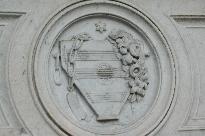
Her tomb by Lord Leighton has a broken slave shackle on a harp
because she hated slavery, though she came from a Jamaican
slave-owning family. 'Death is a slave's freedom' is a Greek
epitaph, Homer saying when a man becomes slave he has but half
his soul. Elizabeth Barrett Browning's Aurora Leigh has two heroines: one based on
Margaret Fuller, Aurora; the other an abandoned gypsy child,
Marian, who is herself. Emily Dickinson then used both Aurora Leigh in her poetry
and treasured a photograph of her tomb. 'The Soul Selects her
own Society, Then Shuts to Door'. Near Elizabeth Barrett
Browning lies Fanny Trollope who wrote the first anti-slavery
novel, Jonathan Jefferson
Whitlaw or Lynch Law. Also we have Richard Hildreth,
who wrote the second anti-slavery novel, The Slave. Harriet Beecher
Stowe copied both of them in her Uncle Tom's Cabin. By Richard Hildreth's is
the tomb of Theodore Parker, who preached so eloquently against
slavery that Frederick Douglass came straight from the station
to his tomb. Douglass, forced by law as a slave to remain
illiterate, taught himself to read and write. You recall that Frederick
Douglass wrote The
Autobiography of an Ex-Slave Written by Himself. The title strongly echoes
the earlier one by St Teresa de Avila, The Autobiography of Teresa de Avila Written by
Herself. To be in our own right, we have to write. And
Mary Somerville buried her husband William here. Now Mary, with
no university education, only a few months of school where she
was placed in an iron contraption for her spine, discovered two
planets and taught mathematics to Ada Lovelace, Lord Byron's
daughter, who then, with Charles Babbage, invented the computer.
At least that is what IBM told us back in the 1950s in Silicon
Valley, where I was in college. Mary's books are exquisitely
written - and were used as science textbooks by the University
of Cambridge in the Victorian period.

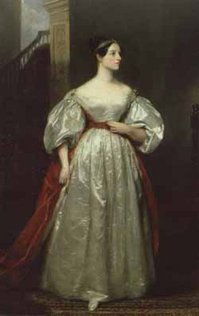
This strange, baggy monster of a website I created, in this new
medium, of electronic coding, of light, instead of ink and
paper, was my Logotherapy, returning to being in my right,
instead of wronged by deans and bishops. The word,
'Logotherapy', was coined by the same psychiatrist as who coined
the word 'Existentialism'. Viktor Frankl was imprisoned in
Auschwitz and the book he was writng, 'Man's Search for Meaning'
destroyed. Inside Auschwitz on hidden scraps of paper, like
Elizabeth Barrett Browning writing her nine-book epic poem and
stuffing the individual pages between the cushions of her
invalid chair to hide them from company, Viktor Frankl rewrote
the lost book. On being freed he took it to Berlin and published
it. Viktor Frankl took issue with both Adler and Freud,
asserting that man's, and woman's, greatest need is not power,
is not sex, but is meaning. Without meaning to our lives we are
not fully alive. Julian of Norwich writes about her earlier
wanting of will, her depression blocking her from life, from
writing, which she overcomes. Through writing, through reading,
we can return to life, our souls be reborn to a lost innocence,
a lost energy. Now my cemetery, my library, have become a place
of meaning. In freeing myself into meaning I can share that
freedom with all. The stories of those buried there, African
slave, Russian serf, English servant, equally buried beside
their Russian and English mistresses, children, for many
children died young in the Victorian period, equal with adults,
women equal with men, all having stories to tell, meanings to
give, lives to share. For instance, two cousins came, seeking
the grave of their ancestress, which they then had restored. How
did she die? I asked. In childbirth. What happened to the child?
Oh, he is our ancestor, too, they said. Her father and her
husband were both clergyman. Imagine the baby's father in
clerical garb travelling back to England with his new-born
motherless orphan. This is Sarah MacCalmont, looking as if she
has stepped straight out of the pages of Jane Austen, whom she
likely read. And she still lives. In the memory of her two
descendants and now in all of ours. Books and tombs preserve
memory, preserve meaning.

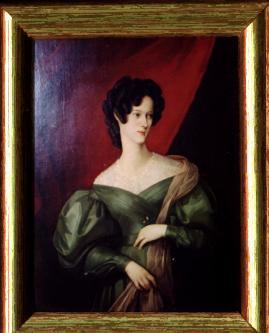
Likewise our books in our library include those on indigenous
and nomadic peoples, currently subject to discriminating
poverty, to trauma, hidden enslavement, that they may be freed
into energy from their current despair: American Indian, Black,
Aborigine, Gypsy. I should like to paint on its ceiling beams
the words Montaigne painted on his study ceiling, words taken
from the Roman playwright Terence, who was a freed slave from
Africa and who wrote the purest Latin, which Cicero would copy,
'Homo sum: humani nihil a me alienum puto'. Changing it
slightly, 'Mulier sum: humani nihil a me alienum puto'. 'We are
human; nothing that is human is alien from us'. This young
writing couple in Pompei likely saw that play, heard those
lines.

Archeology of Websites
http://members.aol.com/juliansite/Juliansite.htm
http://www.geocities.com/Wellesley/9984/julian.html
http://meltingpot.fortunecity.com/ukraine/324/julian.html
http://www.umilta.net
http://www.florin.ms
http://piazzaledonatello.blogspot.com
http://www.thepetitionsite.com/takeaction/471134975?ltl=1171287630
The City and the Book International Conferences
http://www.florin.ms/aleph.html
http://www.florin.ms/beth.html
http://www.florin.ms/gimel.html
http://www.umilta.net
http://www.umilta.net/julian.html
http://www.umilta.net/birgitta.html
http://www.umilta.net/cradle.html
http://www.florin.ms
http://www.florin.ms/ebbwebsite.html
http://www.florin.ms/biblioteca.html
JULIAN
OF NORWICH, HER SHOWING OF LOVE AND ITS CONTEXTS ©1997-2024
JULIA BOLTON HOLLOWAY || JULIAN OF NORWICH || SHOWING OF LOVE || HER TEXTS || HER SELF || ABOUT HER TEXTS || BEFORE JULIAN || HER CONTEMPORARIES || AFTER JULIAN || JULIAN IN OUR TIME || ST BIRGITTA OF SWEDEN
|| BIBLE AND WOMEN || EQUALLY IN GOD'S IMAGE || MIRROR OF SAINTS || BENEDICTINISM || THE CLOISTER || ITS SCRIPTORIUM || AMHERST MANUSCRIPT || PRAYER || CATALOGUE
AND PORTFOLIO (HANDCRAFTS, BOOKS ) || BOOK REVIEWS || BIBLIOGRAPHY ||.
 Wife
and husband, Pompeii
Wife
and husband, Pompeii Wife
and husband, Pompeii
Wife
and husband, Pompeii
 Volmar, Hildegard of Bingen, Richardis
Volmar, Hildegard of Bingen, Richardis
 St Umiltà of Faenza, Florence
St Umiltà of Faenza, Florence

 St Birgitta of Sweden
St Birgitta of Sweden
 Suor
Juana de la Cruz
Suor
Juana de la Cruz  St Teresa de Avila
St Teresa de Avila

 Elizabeth Barrett Browning
Elizabeth Barrett Browning



 Mother Agnes Mason, C.H.F.
Mother Agnes Mason, C.H.F.




 used to accept Heloise's
desperate plea to Abelard that scholars and babies, books and
cradles, pens and distaves, do not mix. I now believe they
can. In our library, that I built, I make cradles, too. I also
remember the line in one of my mother's books, on Austrian
women, that the hand that rocks the cradle is the hand that
rules the world. We women internalize men's contempt for us.
Negating ourselves, striving to be powerful men. [What changed my mind was
Hedera. Hedera is Rom from Romania, who has had two babies
born here in Florence. Soon after the second was born I took
her and her baby and her husband in and they slept in my
cell for a week, following the baptism of little Leonardo in
that cell. While I slept in our library. Cradles are not
meant to be in nuns' or anchoresses' cells! I had already
made a cradle for Hedera, modeled on those I saw in the Rom
camps, but a cradle is not possible when one can only live
in the streets, the Orthodox gypsies not being allowed in
the Moslem gypsy camps. Next, the Romanian gypsies were
rounded up by the Italian police and forced to return to
Romania. So then I made cradles to sell them to benefit
Hedera and her three children, and indeed all the twelve children living with her mother and father in a camp
in Buzau. Later, I succeeded in buying a house for them
there. The children are now going to school, unlike their
mother, learning to read and write.]
used to accept Heloise's
desperate plea to Abelard that scholars and babies, books and
cradles, pens and distaves, do not mix. I now believe they
can. In our library, that I built, I make cradles, too. I also
remember the line in one of my mother's books, on Austrian
women, that the hand that rocks the cradle is the hand that
rules the world. We women internalize men's contempt for us.
Negating ourselves, striving to be powerful men. [What changed my mind was
Hedera. Hedera is Rom from Romania, who has had two babies
born here in Florence. Soon after the second was born I took
her and her baby and her husband in and they slept in my
cell for a week, following the baptism of little Leonardo in
that cell. While I slept in our library. Cradles are not
meant to be in nuns' or anchoresses' cells! I had already
made a cradle for Hedera, modeled on those I saw in the Rom
camps, but a cradle is not possible when one can only live
in the streets, the Orthodox gypsies not being allowed in
the Moslem gypsy camps. Next, the Romanian gypsies were
rounded up by the Italian police and forced to return to
Romania. So then I made cradles to sell them to benefit
Hedera and her three children, and indeed all the twelve children living with her mother and father in a camp
in Buzau. Later, I succeeded in buying a house for them
there. The children are now going to school, unlike their
mother, learning to read and write.]






























